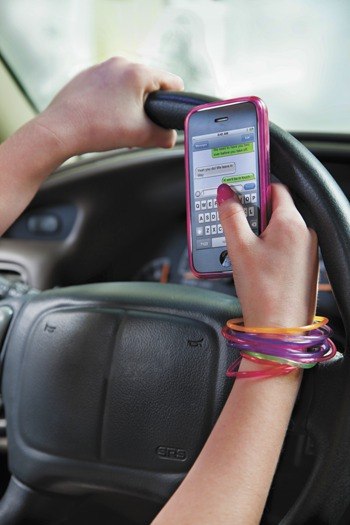The dangerous combination of teens, texting and driving has emerged as a bigger problem on local and national roadways.
Rising statistics of crashes and injuries, even fatalities, suggest a need for more public awareness, peer-to-peer education among teens and involvement from institutions, notably schools.
The dangers of texting and driving are well documented, but according to a survey just released by State Farm Insurance with Harris Interactive, teens still believe it’s OK to text and drive.
A few facts from the survey:
• Texting among teen drivers has not declined: 57 percent of teens admit to texting while driving despite widespread media attention about the dangers of distracted driving.
• Teens who admitted to texting while driving were nearly three times as likely to report being in a car crash.t
• Most teens understand there may be consequences of texting while driving, but do not see it as severe as driving drunk. According to national data from highway safety groups, injuries and deaths related to distracted driving are up. To quantify, 16 percent of all fatal crashes and 20 percent of injury in 2009 across the country involved reports of distracted driving, according to the National Highway Traffic Safety Administration. And the age group with the greatest proportion of distracted drivers was the under-20 group.
In our state, from 2006 to 2008, there were 224,503 drivers involved in injury crashes, of which 20,205 of the crashes (9 percent) were caused by driver distraction of all types.
Concerned officials in the public and traffic safety business consider a driver talking on a cell phone as impaired as a driver with a .08 blood alcohol level; a driver who is texting is as impaired as a driver with a .16 BAC.
If you’re a parent of teenage drivers, as I am, this is alarming stuff.
“It’s a significantly growing problem,” said Sgt. Robert Constant, supervisor of the Kent Police’s traffic unit. “It’s a challenge, especially with a generation that’s so techy, and the urge to text.”
While difficult to quantify, texting drivers are a prevailing problem.
As Constant observed: “It’s generally an upturning trend with everything from the introduction of the iPhone … to a continual barrage of media that’s available, and the attempt to communicate.”
State and local leaders are accelerating the need to address the problem. The problem with and answers to distracted teen driving, as state traffic officials see it, begins at home. Data from the Washington Healthy Youth Survey shows when parents are more involved in the lives of their teens, and enforce clear, consistent rules, risks for drinking, drug use, texting, talking on the cell phone and risky driving are reduced.
“Research shows that good parenting really pays off when it comes to reducing crash risk for teens,” said Jonna VanDyk, occupant protection manager for the Washington Traffic Safety Commission.
Parents can play an important role, but not every teen connects with mom or dad. That’s where the WTSC – with partners like State Farm Insurance – is stepping in.
An ongoing project in that partnership is challenging teen drivers to question themselves.
“Could you be persuaded to put your cell phone in your trunk while you’re driving?” the project asked.
As expected, the reaction was pronounced.
“They really squawked at the idea. No way,” VanDyk said.
Officials have found that teens understand the act is wrong, but are not inclined to do anything about it.
The problem evolves around the teens’ compulsive use of the cell phone, for many the source of their inner-circle communicative world, much of which is nonverbal. That addiction becomes a significant problem when the phone buzzes or lights up while they are occupied behind the wheel.
“It creates a sense of urgency or compulsiveness” when driving to respond to it, VanDyk said. “There is that urge to respond while driving.”
Peer pressure, not wanting to ignore friends, leads to texting and driving. And a new study shows that 75 percent of young adults think there’s nothing wrong with that.
“If this is the way you communicate with your peer group, you’ve become kind of desensitized as to how much that is taking away from whatever else might be demanding your attention,” VanDyk said.
Peer-to-peer education is one way to attack the problem. The WTSC and State Farm, for instance, have gone back to school. There have been discussions, assemblies and other awareness projects. They have teamed up to provide teens with an opportunity, an incentive to take action while earning a $500 grant for a school group such as cheerleading, a sports team, choir or club.
High schools can get involved. Teens need to help each other here. It is a good place to start. It is time to make it a priority.
Hands-free devices are not a cure-all. And teens don’t always do what their parents demand.
“Teens listen to other teens, more so than us,” VanDyk said. “They can persuade fellow teens that texting and driving is dangerous.”


